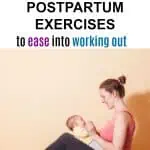3 Safe Postpartum Exercises To Ease Back Into Working Out
This post may contain affiliate links. As an Amazon Associate, I earn from qualifying purchases.
A mom’s body goes through a lot between pregnancy and birth, to say the least. Needless to say, you’ll need some time to rest, recover, and snuggle that sweet new baby.
Yet, it’s no surprise that many new moms are wondering when to start exercising and how to work out to be safe. This article will review exercise guidelines and a few gentle postpartum core exercises you can try when you’re ready.
Postpartum Exercises Guidelines
So, how soon after giving birth can you exercise?
We all want to start doing safe postpartum exercises to help flatten the tummy as soon as possible, but that’s not a good idea! Instead, you need to focus on your postpartum recovery and allow your body to heal for 6 to 8 weeks before taking up any targeted exercise routine.
Waiting that long is a good idea, no matter if you had a vaginal delivery or cesarean. Once you’re past the initial postpartum recovery time, exercise will help you have new energy as a new mom which will keep your mind focused so you can take care of your newborn baby.
Does that mean you have to sit on the couch for 6 weeks? For some moms, yes. But other moms, need daily movement for both mental and physical health. So you’ll have to find what works best for you based on your personal preferences and what your doctor tells you.
RELATED READ: Postpartum Recovery Plan for New Moms
Postpartum Exercises To Avoid

There are some exercises that are particularly hard on the postpartum body. These include:
- High-impact activities post-pregnancy can cause unnecessary pressure on the pelvic floor muscles.
- Ab exercises – like crunches or planks – can cause diastasis recti (or, more likely, exacerbate), which is when the abdominal muscles split, which is a separation of the abdominal wall.
- Women also tend to think they need to do a lot of abdominal workouts (like crunches and planks) to get their core back in shape, but those exercises are actually not the best exercises to do in order to flatten your tummy postpartum.
- Any exercise that causes increased bleeding.
- Any movement that causes your belly to “dome” or pooch. If you look down and your stomach has assumed a strange shape (looking more like a pyramid than flat)- it means the exercise is too hard. At first, everything may be too hard! I remember in my first 6 weeks, I couldn’t even get on the ground without my abs pooching.
- In general, avoid all abs exercises, at least for the first few months post-pregnancy!
(Don’t worry! Your tummy will begin to shrink on its own – it just takes time)
Safe Post Pregnancy Exercising
Postpartum core exercise (and postpartum pelvic floor exercise) is beneficial for all new moms, whether you worked out during your pregnancy or not. Adding some light exercise post-pregnancy will help your overall mental well-being as you adjust to life with your newborn baby.
Exercise lowers stress which may help curb postpartum depression or other feelings of sadness.
Another bonus? Post pregnancy workouts will start you on the path to losing your baby weight.
So, are there really any safe postpartum exercises you can do during the first 6 to 8 weeks? Yes, there are!
Workouts such as:
- Walking
- Isolation exercises
- Low-intensity workouts
- Foam rolling and gentle stretching or yoga
Here are 3 exercise routines you can start doing right now:
(Note: Please consult with your healthcare provider before starting any workout routine; it’s always nice to get the green light from them!)
What you’ll need for the workouts:
- Comfy clothes
- A yoga mat
- Two bottles of water or light dumbbells
The following exercises are safe and will help you establish good core and pelvic floor connections and breathing patterns.
Exercise 0: Mindful Breathing
First things first, work on our breathing.
Start bylLying on your back with bent knees and feet flat on the floor. Relax your glutes and place one hand on the side of the rib cage and the other hand on the lower belly. Feel the connection when you breathe while you inhale and exhale; you can feel it with your hands. You should feel the belly rise and lowermost of all (rather than the chest and neck).
Once you get the breathing connection, known as diaphragmatic breathing, carry this breath through the rest of the exercises.
Exercise 1: Mini-Bridge
Lie on your back with knees bent, arms down by the side of your body, and feet flat on the floor.
Inhale, gently engage the abdominals, and squeeze your glutes to lift your hips off the floor. At first, you might not be able to actually lift without your abs feeling weird- that’s okay. Modify as much as you need to!
Repeat for 10 repetitions for a few sets. Gradually progress as tolerated.
Exercise 2: Pelvic Tilts
Lie on your back with your knees bent and feet flat on the floor. Place one hand on your abdomen and the other just above your pubic bone.
Inhale as you gently engage your abdominals and tilt your pelvis to arch your lower back off the ground. Exhale as you relax the abs and return to the starting position.
Repeat for 10 repetitions as needed during the day. When you’re reading to progress, you can experiment with moving your legs for an extra challenge (such as lifting one foot off the ground).
Exercise 3: Functional Strength
A great way to heal and strengthen your pelvic floor and abs are to use the exhale/inhale breathing technique and a simple, functional movement exercise.
For example, bicep curls with light dumbbells or using two bottles of water. You are going to naturally contract the pelvic floor with this basic move- as long as you focus on keeping good form and breathing.
Related read: Why You Need Postpartum Physical Therapy
Take Your Time, Mama!
The key to working out postpartum is to ease back in by using exercises that heal and strengthen your core and pelvic floor.
Follow the tips above, and you’ll be on your way. Don’t be afraid to ask and trust in your body’s ability to heal.
YOU MAY ALSO LIKE:








